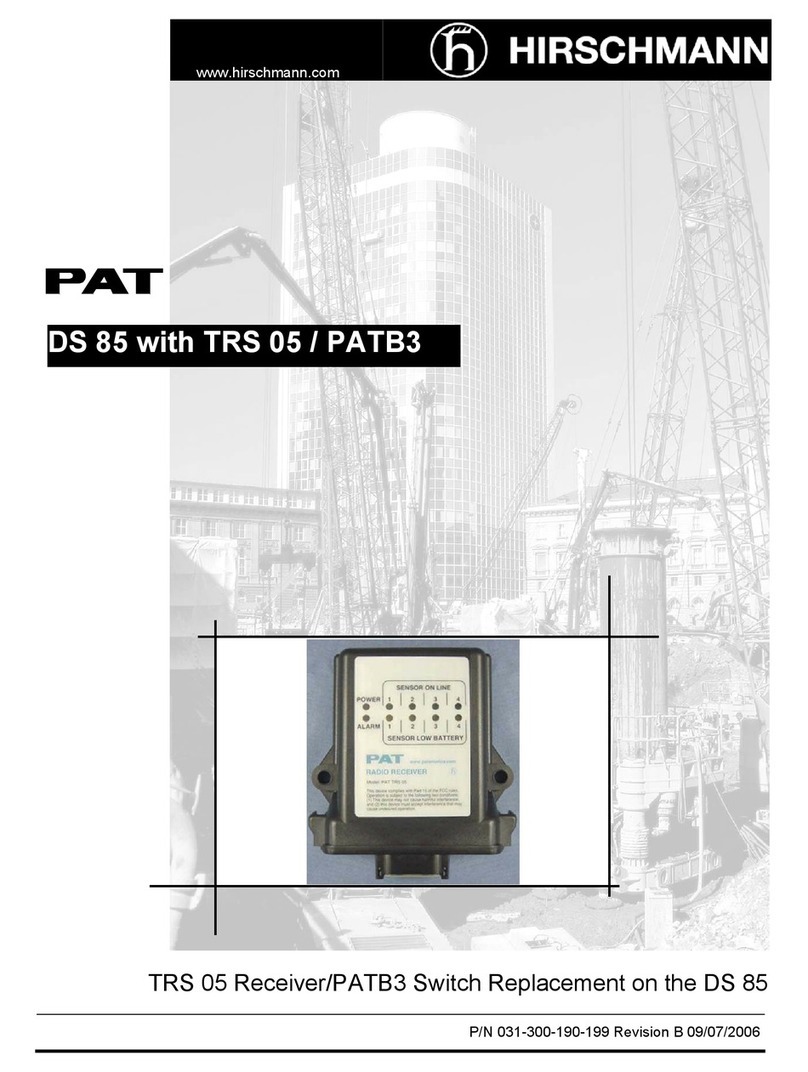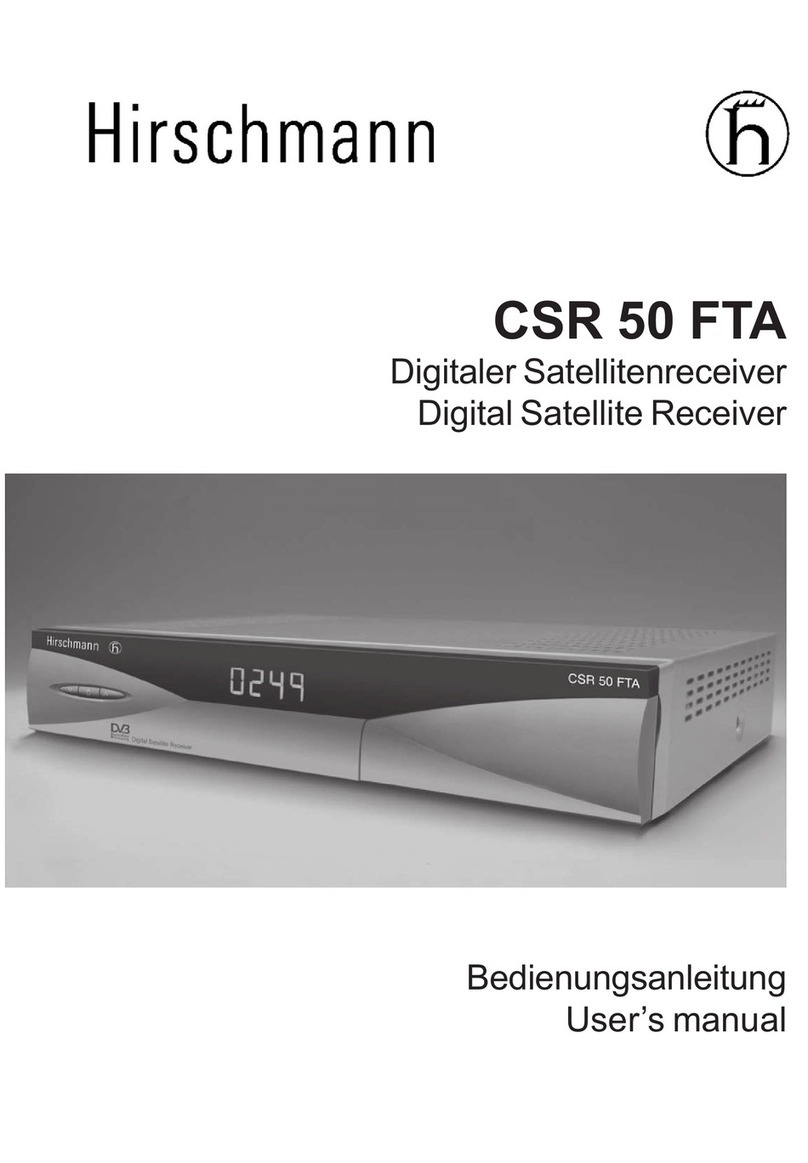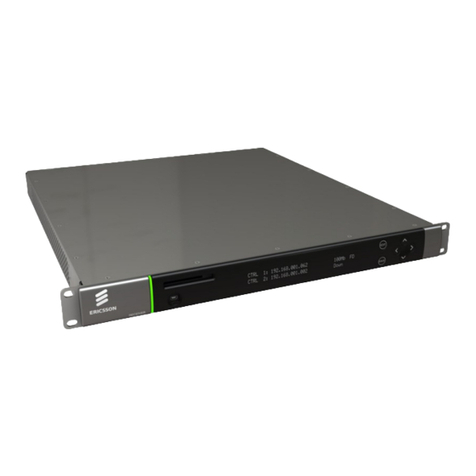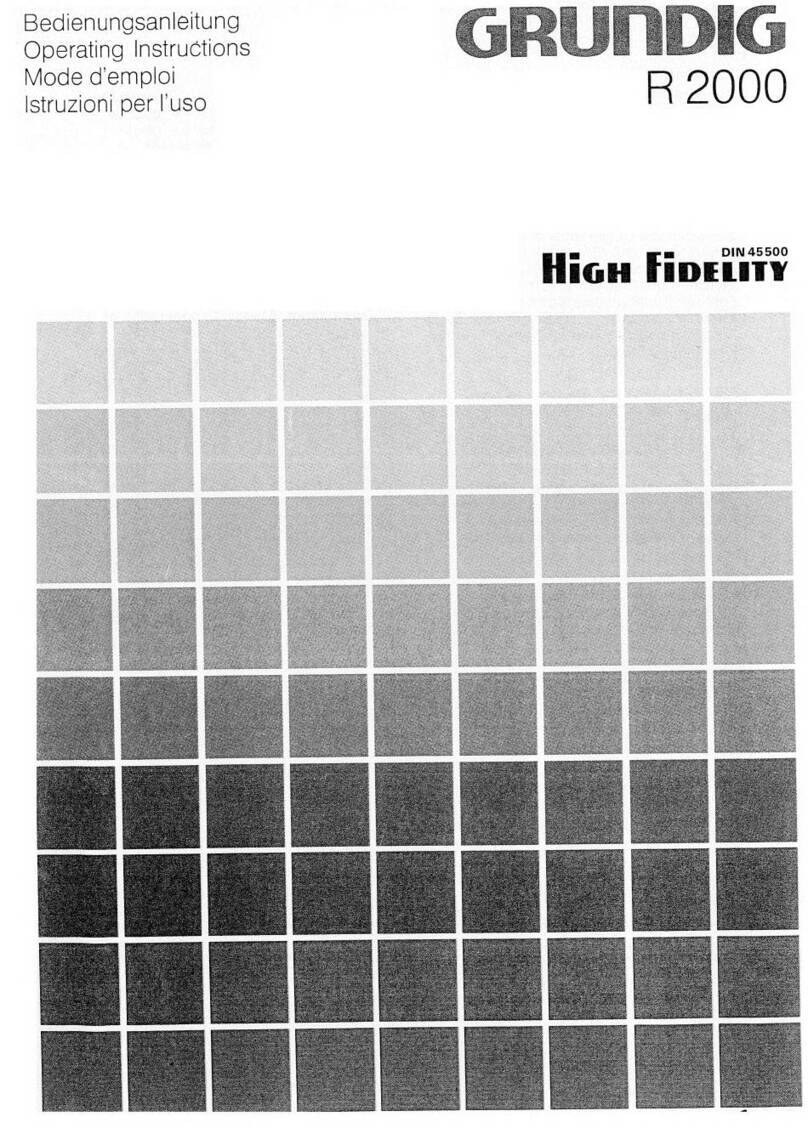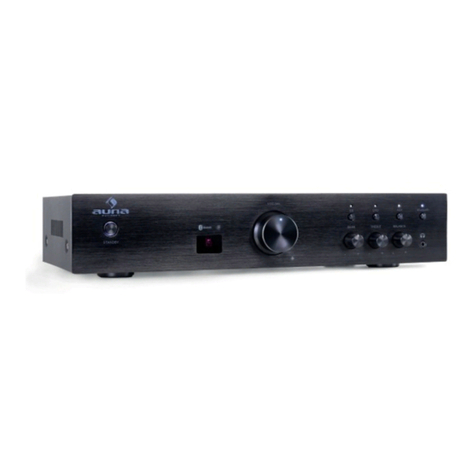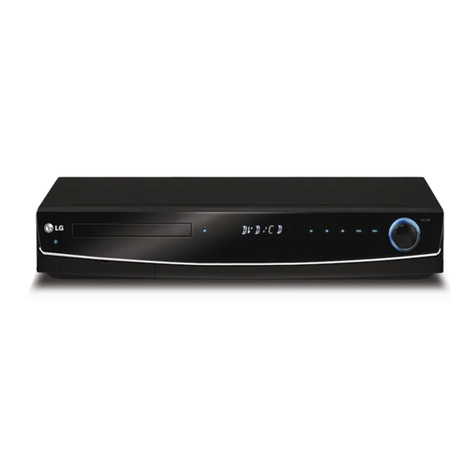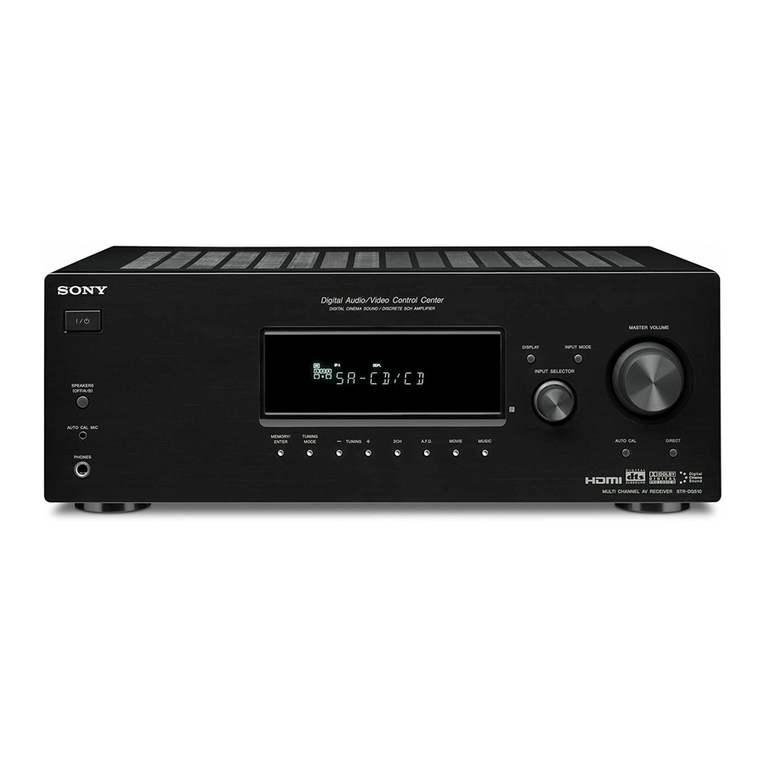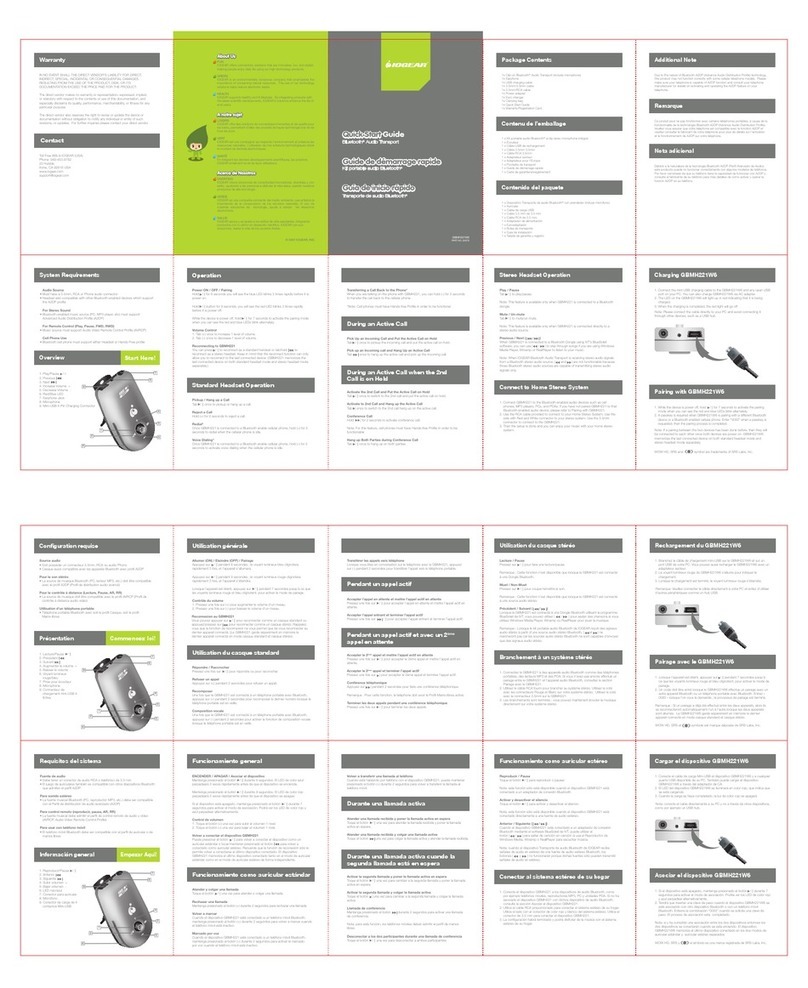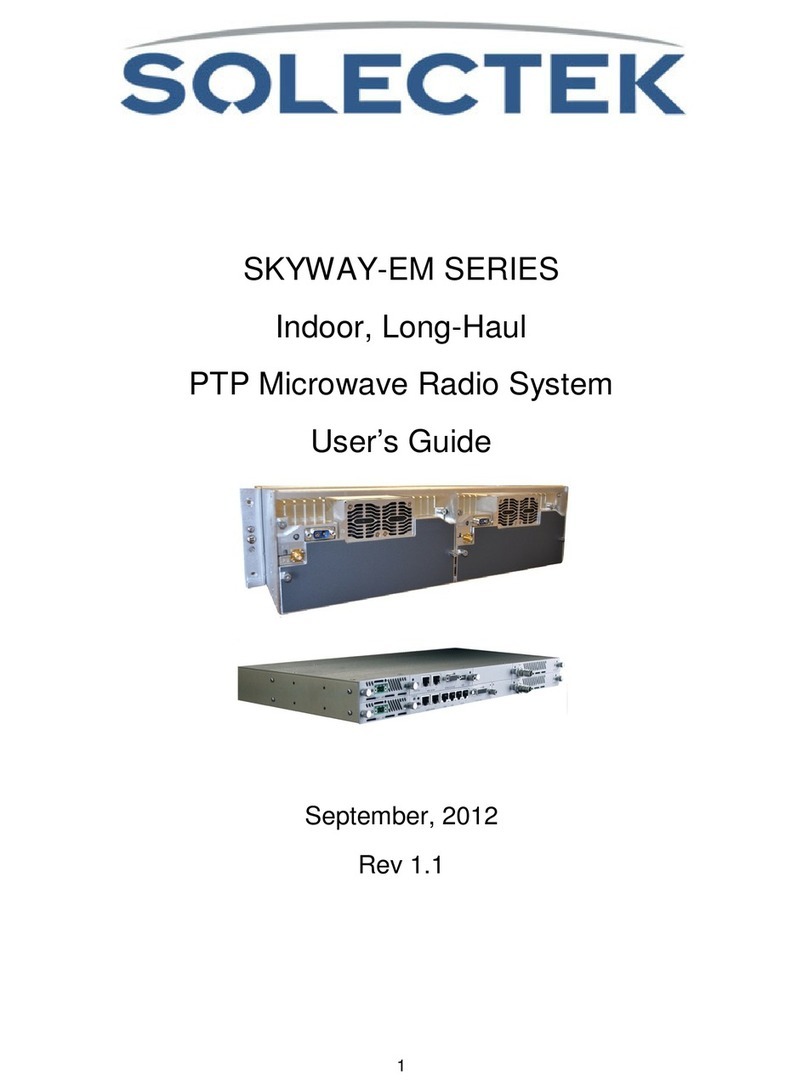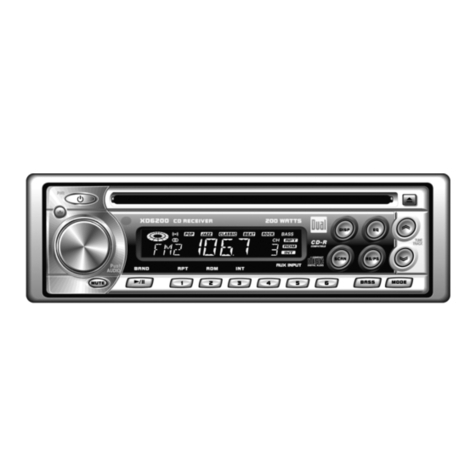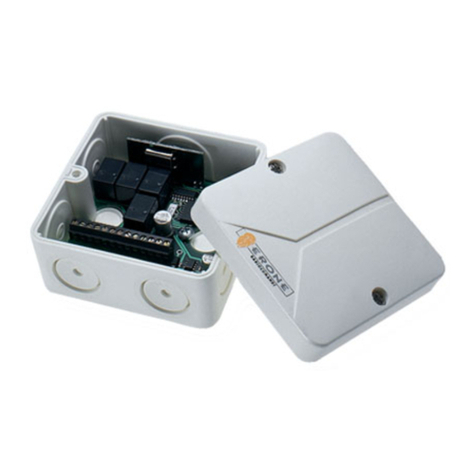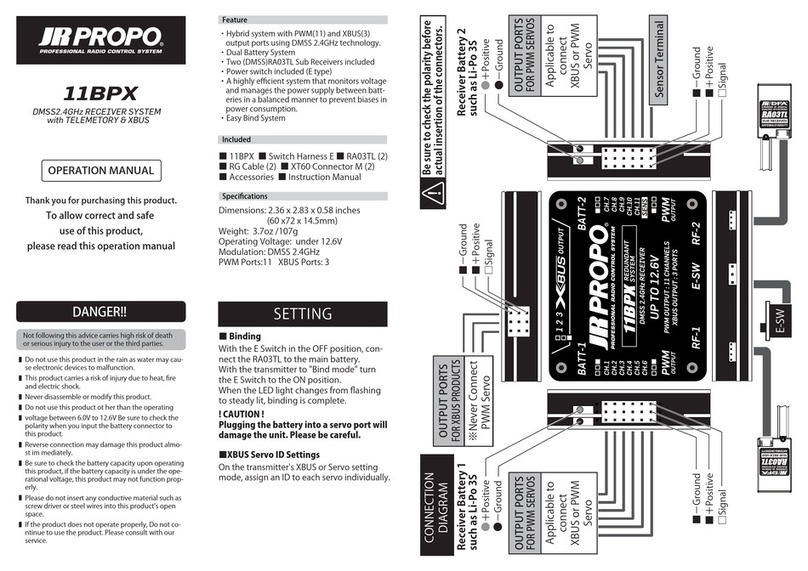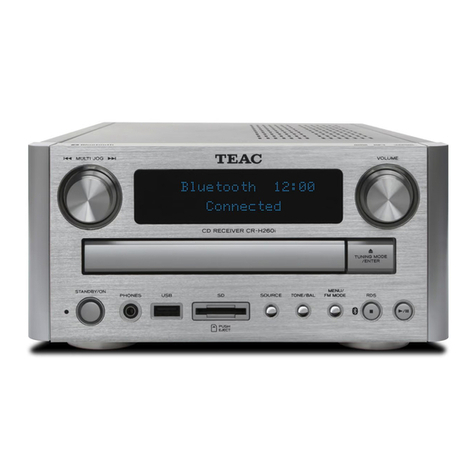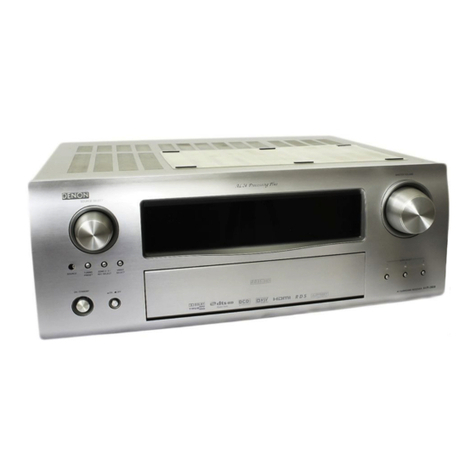Hirschmann OEV 801-E BFOC Manual

Störsichere Video-Signalübertragung
Signalbandbreite 80 MHz
Bildunabhängige Regelautomatik
19"-Einschubkarten
Optische Anschlüsse:
Bauform BFOC 2,5 (ST ® ) oder FSMA
Interference-free video signal transmission
Signal bandwidth 80 MHz
Image-independent automatic control
19" plug-in cards
Optical connections:
Type BFOC 2,5 (ST ® ) or FSMA
Beschreibung und Betriebsanleitung
Optischer Video-Empfänger
Description and Operating Instructions
Optical Video Receiver OEV 801-E FSMA
Bestell-Nr. / Ord. code
933 798-001
OEV 801-E BFOC
Bestell-Nr. / Ord. code
933 798-021

D
Wir haben den Inhalt der Druckschrift auf Über-
einstimmung mit der beschriebenen Hard- und
Software geprüft. Dennoch können Abwei-
chungen nicht ausgeschlossen werden, so
dass wir für die vollständige Übereinstimmung
keine Gewähr übernehmen. Die Angaben in
der Druckschrift werden jedoch regelmäßig
überprüft. Notwendige Korrekturen sind in den
nachfolgenden Auflagen enthalten. Für Ver-
besserungsvorschläge sind wir dankbar.
Technische Änderungen vorbehalten.
Weitergabe sowie Vervielfältigung dieser Unter-
lage, Verwertung und Mitteilung ihres Inhalts
ist nicht gestattet, soweit nicht ausdrücklich
zugestanden. Zuwiderhandlungen verpflichten
zu Schadensersatz. Alle Rechte vorbehalten,
insbesondere für den Fall der Patenterteilung
oder GM-Eintragung.
© Hirschmann Electronics GmbH & Co. KG
2003
All Rights Reserved
Hinweis
Wir weisen darauf hin, dass der Inhalt dieser
Betriebsanleitung nicht Teil einer früheren oder
bestehenden Vereinbarung, Zusage oder eines
Rechtsverhältnisses ist oder diese abändern
soll. Sämtliche Verpflichtungen von Hirschmann
ergeben sich aus dem jeweiligen Kaufvertrag,
der auch die vollständige und allein gültige
Gewährleistungsregel enthält. Diese vertrag-
lichen Gewährleistungsbestimmungen werden
durch die Ausführungen dieser Betriebsanlei-
tung weder erweitert noch beschränkt.
Wir weisen außerdem darauf hin, dass aus
Gründen der Übersichtlichkeit in dieser
Betriebsanleitung nicht jede nur erdenkliche
Problemstellung im Zusammenhang mit dem
Einsatz dieses Gerätes beschrieben werden
kann. Sollten Sie weitere Informationen be-
nötigen oder sollten besondere Probleme auf-
treten, die in der Betriebsanleitung nicht aus-
führlich genug behandelt werden, können Sie
die erforderliche Auskunft über den Hirsch-
mann-Vertragspartner in Ihrer Nähe oder direkt
bei Hirschmann (Adresse siehe im Abschnitt
„Hinweis zur CE-Kennzeichnung“) anfordern.
Sicherheitstechnische
Hinweise
Dieses Handbuch enthält Hinweise, die Sie zu
Ihrer persönlichen Sicherheit, sowie zur Ver-
meidung von Sachschäden beachten müssen.
Die Hinweise sind durch ein Warndreieck her-
vorgehoben und je nach Gefährdungsgrad
folgendermaßen dargestellt:
zGefahr!
bedeutet, dass Tod, schwere Körper-
verletzung oder erheblicher Sach-
schaden eintreten werden, wenn die
entsprechenden Vorsichtsmaßnahmen
nicht getroffen werden.
zWarnung!
bedeutet, dass Tod, schwere Körper-
verletzung oder erheblicher Sach-
schaden eintreten können, wenn die
entsprechenden Vorsichtsmaßnahmen
nicht getroffen werden.
zVorsicht!
bedeutet, dass eine leichte Körperver-
letzung oder ein Sachschaden eintre-
ten können, wenn die entsprechenden
Vorsichtsmaßnahmen nicht getroffen
werden.
Hinweis:
ist eine wichtige Information über das Produkt,
die Handhabung des Produktes oder den
jeweiligen Teil der Dokumentation, auf den
besonders aufmerksam gemacht werden soll.
Anforderung an die Qualifika-
tion des Personals
Hinweis:
Qualifiziertes Personal im Sinne dieser Betriebs-
anleitung bzw. der Warnhinweise sind Personen,
die mit Aufstellung, Montage, Inbetriebsetzung
und Betrieb dieses Produktes vertraut sind
und die über die ihrer Tätigkeit entsprechenden
Qualifikationen verfügen, wie z.B.:
– Ausbildung oder Unterweisung bzw. Berech-
tigung, Stromkreise und Geräte bzw. Systeme
gemäß den aktuellen Standards der Sicher-
heitstechnik ein- und auszuschalten, zu
erden und zu kennzeichnen;
– Ausbildung oder Unterweisung gemäß den
aktuellen Standards der Sicherheitstechnik
in Pflege und Gebrauch angemessener
Sicherheitsausrüstungen;
– Schulung in Erster Hilfe.
Bestimmungsgemäßer Gebrauch
Bitte beachten Sie folgendes:
zWarnung!
Das Gerät darf nur für die im Katalog
und in der technischen Beschreibung
vorgesehenen Einsatzfälle und nur in
Verbindung mit von Hirschmann emp-
fohlenen bzw. zugelassenen Fremd-
geräten und -komponenten verwendet
werden. Der einwandfreie und sichere
Betrieb des Produktes setzt sachge-
mäßen Transport, sachgemäße Lage-
rung, Aufstellung und Montage sowie
sorgfältige Bedienung und Instand-
haltung voraus.
Allgemeine Sicherheits-
vorschriften
䊳Dieses Gerät wird mit Elektrizität betrieben.
Beachten Sie genauestens die in der Be-
triebsanleitung vorgeschriebenen Sicher-
heitsanforderungen an die anzulegenden
Spannungen!
䊳Achten Sie auf die Übereinstimmung der
elektrischen Installation mit lokalen oder
nationalen Sicherheitsvorschriften.
zWarnung!
Bei Nichtbeachten der Warnhinweise
können schwere Körperverletzungen
und/oder Sachschäden auftreten. Nur
entsprechend qualifiziertes Personal
sollte an diesem Gerät oder in dessen
Nähe arbeiten. Dieses Personal muss
gründlich mit allen Warnungen und
Instandhaltungsmaßnahmen gemäß
dieser Betriebsanleitung vertraut sein.
Der einwandfreie und sichere Betrieb
dieses Gerätes setzt sachgemäßen
Transport, fachgerechte Lagerung und
Montage sowie sorgfältige Bedienung
und Instandhaltung voraus.
zWarnung!
Eventuell notwendige Arbeiten an der
Elektroinstallation dürfen nur von einer
hierfür ausgebildeten Fachkraft durch-
geführt werden.
Sicherheitshinweise Umgebung
zWarnung!
Das Gerät darf nur bei der angege-
benen Umgebungstemperatur und
bei der angegebenen relativen Luft-
feuchtigkeit (nicht kondensierend)
betrieben werden.
䊳Wählen Sie den Montageort so, dass die in
den Technischen Daten angegebenen klima-
tischen Grenzwerte eingehalten werden.
Zugrundeliegende Normen und
Standards
Die Geräte erfüllen folgende Normen und
Standards:
– EN 61000-6-2:1999 Fachgrundnorm –
Störfestigkeit Industriebereich
– EN 55022:1998 – Funkstöreigenschaften für
Einrichtungen der Informationstechnik
– EN 60950:1997 – Sicherheit von
Einrichtungen der Informationstechnik
Hinweis zur CE-Kennzeichnung
7Die Geräte stimmen mit den Vor-
schriften der folgenden Europäischen
Richtlinie überein:
89/336/EWG
Richtlinie des Rates zur Angleichung der
Rechtsvorschriften der Mitgliedstaaten über
die elektromagnetische Verträglichkeit (geän-
dert durch RL 91/263/EWG, 92/31/EWG und
93/68/EWG).
Die EU-Konformitätserklärung wird gemäß der
obengenannten EU-Richtlinien für die zustän-
digen Behörden zur Verfügung gehalten bei:
Hirschmann Electronics GmbH & Co. KG
Automation and Network Solutions
Stuttgarter Straße 45-51
72654 Neckartenzlingen
Telefon 01805-141538
E-Mail [email protected]
Recycling Hinweis
,Dieses Produkt ist nach seiner Ver-
wendung entsprechend den aktuellen
Entsorgungsvorschriften Ihres Land-
kreises / Landes / Staates als Elek-
tronikschrott einer geordneten Ent-
sorgung zuzuführen.

Inbetriebnahme
In der Standard-Betriebsart sind keine Einstel-
lungen und Abgleicharbeiten notwendig. Die
werkseitige Einstellung ist gültig.
Standard-Betriebsart
Die synchronimpulsorientierte Regelautomatik
regelt in der Standard-Betriebsart mit dem
internen Sollwert die Ausgangsspannung auf
1 VSS an 75 Ωbei einem Bild mit Weißanteil.
Einstellen der Ausgangsspannung
Mit DIP-Schalter S 1 und Potentiometer P 1 ist
die Ausgangsspannung veränderbar.
(S 2 muss hierzu auf OFF stehen).
Schalter S 1 ON:
Sollwertveränderung der Ausgangsspannung
mit Mehrgangpotentiometer P 1 (ca. 3 Um-
drehungen).
minimale Ausgangsspannung
maximale Ausgangsspannung
Werkseitige Einstellung: Schalterstellung OFF;
interner Sollwert (1 VSS an 75 Ω) wirksam.
Einstellen der Verstärkung
Die Verstärkung kann manuell eingestellt wer-
den, wenn z. B. die synchronimpulsorientierte
Regelautomatik nicht gewünscht wird.
Mit DIP-Schalter S 2 und Potentiometer P 2
wird die Verstärkung eingestellt.
(S 1 muss hierzu auf ON und P 1 auf Rechts-
anschlag stehen – durch „Klicken“ des Poten-
tiometers hörbar).
Schalter S 2 ON:
Veränderung der Ausgangsspannung mit
Mehrgangpotentiometer P 2 (ca. 3 Umdre-
hungen)
maximale Verstärkung
minimale Verstärkung
Werkseitige Einstellung: Schalter S 2 OFF;
synchronimpulsorientierte Regelautomatik
eingeschaltet.
3 x
3 x
3 x
3 x
Abschalten der LED S
Befinden sich DIP-Schalter S 3 und S 4 in
Stellung ON, so ist LED S außer Funktion.
Ist die Standard-Betriebsart nicht gewählt, kann
die LED S die Überwachung der optischen
Eingangsleistung eventuell nicht mehr korrekt
anzeigen.
Werkseitige Einstellung: S 3 und S 4 in Stel-
lung OFF (LED Funktion wie unter „LED-An-
zeigen“ beschrieben).
Anschließen
䊳Stecken Sie die 19"-Einschubkarte in einen
Baugruppenträger ART … (oder BGTS …)
und schrauben Sie sie fest.
䊳Schließen Sie das Koax- und LWL-Kabel
(je nach Bauform der 19"-Einschubkarte mit
BFOC 2,5 oder F-SMA Steckern) an.
䊳Schalten Sie die Netzspannung an dem
Baugruppenträger an. Danach ist der
Optische Video-Empfänger OEV 801-E …
sofort betriebsbereit.
Lage der DIP-Schalter und der Potentiometer auf der Leiterplatte
Beschreibung
Der Optische Video-Empfänger OEV 801-E …
dient zur Übertragung eines Video-Signals
über Quarzglas-LWL.
Er empfängt die optischen Signale der Sender
OSVR 80M2-E … , OSVC 01…, OSV 052 …
oder OSVR 150M-PCI64 … und bereitet sie
elektrisch auf.
Der Empfänger OEV 801-E … besteht aus
einer 3 Teileinheiten breiten 19"-Einschubkarte
mit optisch/elektrischem Wandler, einer
elektronischen Schaltung zur Signalaufberei-
tung und einem Anschluss für ein optisches
Eingangssignal sowie ein elektrisches Aus-
gangssignal.
Der optische Anschluss und die Videosignal-
leitung sind von vorne zugänglich. Die Strom-
versorgung erfolgt über die 32polige Feder-
leiste des Baugruppenträgers.
S4
S3
ON
S1
S2
ON
P1
P2
O
E
Optisches
V
ideo-
Signal
Video-
Normschnitt-
stelle
Regelung
und
Verstärkung
Opto-elektrischer
Wandler
LED-Anzeigen
Der Optische Video-Empfänger OEV 801-E …
verfügt über zwei LEDs auf der Frontblende.
– Die grüne LED Pleuchtet bei anliegender
Versorgungsspannung.
– Die rote LED Sleuchtet kontinuierlich, wenn
das empfangene optische Videosignal zu
schwach ist und blinkt, wenn das empfangene
optische Videosignal zu stark ist (Optischer
Video-Empfänger wird übersteuert).
Abhilfemaßnahmen bei Übersteuerung
In wenigen Anwendungsfällen kann es zum
dauernden Blinken der roten LED S kommen
– insbesondere bei Kombination einer
62,5/125 µm Faser und einer Faserlänge
kleiner 300 m.
䊳Verwenden Sie zur Abhilfe ein optisches
Dämpfungsglied (Dämpfung > 1,5 dB) oder
erhöhen Sie Ihre Faserdämpfung um
ca.1,5 dB (längere Faser, Vorlauffaser,
zusätzliche optische Steckverbindung).
Der Empfänger kann ohne Abgleich in Betrieb
genommen werden.
Er verfügt über eine synchronimpulsorientierte
Regelautomatik, die bei allen üblichen Zeilen-
und Bildfrequenzen unabhängig vom Bildinhalt
arbeitet. Zur manuellen Einstellung der Ver-
stärkung ist die Regelung mit Hilfe eines DIP-
Schalters abschaltbar.
Zur Veränderung der Ausgangsspannung dient
ein Potentiometer, das durch einen weiteren
DIP-Schalter zugeschaltet wird.
Blockschaltbild

20
40
30
B/MHz
10
60
50
100 200 400 600 1000 2000 l/m
80
100 OSVR 80M2-E
/
OSVR 150M-PCI64 …
OSV 052 …
OSVC 01 …
100
10
1
A
B
706050012345l/km
S
N
—/dB
ss
P/µW
Übersteuerungsgrenze
Faser G 50/125
Faser G 62,5/125
Empfindlichkeitsgrenze
Systembandbreite in
Abhängigkeit von der Faserlänge
Kombinationsmöglichkeiten
Kombination mit Sender OSVR 80M2-E … OSVC 01 … OSV 052 … OSVR 150M-PCI64 …
Überbrückbare Entfernung mit 3 dB
Systemreserve/Streckendämpfung
– mit Faser G 50/125 µm (3,0 dB/km) 1300 m 2) / 1200 m/ 1300 m 1) / 1000 m2) /
7dB (A) 6,5 dB 7 dB (A) 6 dB
– mit Faser G 62,5/125 µm (3,5 dB/km) 1700 m 2)/ 300 - 1400 m/ 300 - 1700 m 1) / 300 - 1400 m2) /
9 dB (B) 8 dB 9 dB (B) 8 dB
1) Bandbreitenbegrenzung ab 1000 m
2) Bandbreitenbegrenzung ab 400 m
Pegeldiagramm mit Verlauf des
Signal/Rauschabstandes
mit Sender OSVR 80M2-E oder OSV 052 …
und Faser G 50/125 µm oder G 62,5/125 µm

Technische Daten
Typ OEV 801-E BFOC OEV 801-E FSMA
Betriebsspannung 17,6 V bis 24 V
Stromaufnahme 150 mA
Elektrische Schnittstelle
Ausgangsspannung 1 VSS an 75 Ωbei einem Bild mit Weissanteil
Ausgangswiderstand 75 Ω
Obere Grenzfrequenz (–3 dB) 80 MHz
Dachschräge (horizontal und vertikal) < 3%
Differentielle Phase typ. 3°
Optische Schnittstelle
Wellenlänge 860 nm
Optische Eingangsleistung min. 3 µWSS, –25 dBm
bei S/N > 48 dBw
Übersteuerungsgrenze 25 µWSS, –16 dBm
Anschlüsse
Vorderseite
Video BNC-Buchse
Opto BFOC 2,5 (ST ® ) F-SMA
Rückseite
Betriebsspannung Messerleiste nach DIN 41 612, Bauform B; PIN 1: Masse, PIN 32: +UB
Anzeigen
Grüne LED (P) An – Betriebsspannung vorhanden
Rote LED (S) An – Zu geringe optische Eingangsleistung
Blinkt – Optischer Empfänger ist übersteuert
DIP-Schalter/Einstellregler
S 1 : Ausgangsspannung
ON: Abhängig von P 1; OFF: interner Sollwert
S 2 : Verstärkung
ON: Abhängig von P 2; OFF: synchronimpulsorientierte Regelautomatik
S 3 und S 4: Funktion von LED S
ON: stets ausgeschaltet; OFF: Funktion wie oben beschrieben
P 1: Ausgangsspannung
P 2: Verstärkung
EMV-Grenzwerte 1)
Störaussendung Erfüllt EN 55022; Grenzwertklasse B
Störfestigkeit Erfüllt EN 55024, EN 61000-6-2
Umgebungstemperatur 0 °C bis +50 °C
Lagerungstemperatur –20 °C bis +80 °C
Relative Luftfeuchtigkeit 10 % bis 90 % (nicht kondensierend)
Masse 150 g
Abmessungen B x H x T 15 (¥3 TE) x 128,5 (¥3 HE) x 185 mm
1) Montiert in 19"-Baugruppenträger
Lieferumfang
Typ OEV 801-E BFOC OEV 801-E FSMA
1 Empfängereinschubkarte 1 Empfängereinschubkarte
1 Beschreibung und Betriebsanleitung 1 Beschreibung und Betriebsanleitung
Zubehör (gesondert zu bestellen)
19"-Baugruppenträger ART 42 ART 84
Bestell-Nr. 933 845-001 933 797-001

We have checked that the contents of the
technical publication agree with the hardware
and software described. However, it is not
possible to rule out deviations completely, so
we are unable to guarantee complete agree-
ment. However, the details in the technical
publication are checked regularly. Any cor-
rections which prove necessary are contained
in subsequent editions. We are grateful for
suggestions for improvement.
We reserve the right to make technical
modifications.
Permission is not given for the circulation or
reproduction of this document, its use or the
passing on of its contents unless granted
expressly. Contravention renders the perpetrator
liable for compensation for damages. All rights
reserved, in particular in the case of patent
grant or registration of a utility or design.
© Hirschmann Electronics GmbH & Co. KG
2003
All Rights Reserved
Note
We would point out that the content of these
operating instructions is not part of, nor is it
intended to amend an earlier or existing agree-
ment, permit or legal relation-ship. All obliga-
tions on Hirschmann arise from the respective
purchasing agreement which also contains the
full warranty conditions which have sole appli-
cability. These contractual warranty conditions
are neither extended nor restricted by com-
ments in these operating instructions.
We would furthermore point out that for reasons
of simplicity, these operating instructions
cannot describe every conceivable problem
associated with the use of this equipment.
Should you require further information or
should particular problems occur which are
not treated in sufficient detail in the operating
instructions, you can request the necessary
information from your local Hirschmann sales
partner or directly from the Hirschmann office
(address: refer to chapter entitled „Notes on
CE identification“).
Safety Instructions
This manual contains instructions which must
be observed to ensure your own personal
safety and to avoid damage to devices and
machinery. The instructions are highlighted
with a warning triangle and are shown as fol-
lows according to the degree of endangerment:
zDanger!
means that death, serious injury or
considerable damage to property will
result if the appropriate safety measures
are not taken.
zWarning!
means that death, serious injury or
considerable damage to property can
result if the appropriate safety
measures are not taken.
zCaution!
means that light injury or damage to
property can result if the appropriate
safety measures are not taken.
Note:
is an important piece of information about the
product, how to use the product, or the relevant
section of the documentation to which particular
attention is to be drawn.
Staff qualification requirements
Note:
Qualified personnel, as understood in this
manual and in the warning signs, are persons
who are familiar with the setup, assembly,
startup, and operation of this product and are
appropriately qualified for their job. This
includes, for example, those persons who
have been:
– trained or directed or authorized to switch on
and off, to ground and to label power circuits
and devices or systems in accordance with
current safety engineering standards
– trained or directed in the care and use of
appropriate safety equipment in accordance
with the current standards of safety
engineering
– trained in providing first aid.
Certified usage
Please observe the following:
zWarning!
The device may only be employed for
the purposes described in the catalog
and technical description, and only in
conjunction with external devices and
components recommended or
approved by Hirschmann. The product
can only be operated correctly and
safely if it is transported, stored,
installed and assembled properly and
correctly. Furthermore, it must be
operated and serviced carefully.
General Safety Instructions
䊳This device is electrically operated. Adhere
strictly to the safety requirements relating to
voltages applied to the device as described
in the operating instructions!
䊳Make sure that the electrical installation
meets local or nationally applicable safety
regulations.
zWarning!
Failure to observe the information
given in the warnings could result in
serious injury and/or major damage.
Only personnel that have received
appropriate training should operate
this device or work in its immediate
vicinity. The personnel must be fully
familiar with all of the warnings and
maintenance measures in these
operating instructions.
Correct transport, storage, and
assembly as well as careful operation
and maintenance are essential in
ensuring safe and reliable operation
of this device.
zWarning!
Any work that may have to be per-
formed on the electrical installation
should be performed by fully qualified
technicians only.
Safety Guidelines Environment
zWarning!
The device may only be operated in
the listed ambient temperature range
at the listed relative air humidity (non-
condensing).
䊳The installation location is to be selected so
as to ensure compliance with the climatic
limits listed in the Technical Data.
Based specifications and
standards
The devices fulfil the following specifications
and standards:
– EN 61000-6-2:1999 Generic standards –
Immunity for industrial environments
– EN 55022:1998 – Information technology
equipment – Radio disturbance
characteristics
– EN 60950:1997 – Safety of Information
Technology Equipment (ITE)
Notes on CE identification
7The devices comply with the
regulations of the following European
directive:
89/336/EEC
Council Directive on the harmonization of the
legal regulations of member states on electro-
magnetic compatibility (amended
by Directives 91/263/EEC, 92/31/EEC and
93/68/EEC).
The EU declaration of conformity is kept
available for the responsible authorities in
accordance with the above-mentioned EU
directives at:
Hirschmann Electronics GmbH & Co. KG
Automation and Network Solutions
Stuttgarter Straße 45-51
72654 Neckartenzlingen
Telephone ++49-7127-14-1538
E-mail [email protected]
Recycling Note
,After its use, this product has to be
processed as electronic scrap and dis-
posed of according to the prevailing
waste disposal regulations of your
community/district /country/state.
GB

Setting up
No settings or tuning work are required in the
standard operating mode. The works setting
applies.
Standard operating mode
In the standard operating mode, the sync
pulse-oriented automatic control function
regulates the output voltage to 1 VPP at 75 Ω
in the case of an image with white content,
using the internal setpoint.
Setting the output voltage
The output voltage can be varied with the DIP
switch S 1 and potentiometer P 1.
(S 2 must be set to OFF in this case).
Switch S 1 ON:
Setpoint variation of the output voltage
with multi-turn potentiometer P 1 (approx.
3 rotations).
minimum output voltage
maximum output voltage
Works setting: Switch position OFF; internal
setpoint (1 VPP at 75 Ω) active.
Setting the gain
The gain can be set manually if sync pulse-
oriented automatic control is not required for
instance.
The gain is set with DIP switch S 2 and poten-
tiometer P 2.
(S 1 must be set to ON in this case and P 1
must be set to fully clockwise position).
Switch S 2 ON:
Varying the output voltage with multi-turn
potentiometer P 2 (approx. 3 rotations).
maximum gain
minimum gain
Works setting: Switch S 2 OFF: Sync pulse-
oriented automatic control function activated.
3 x
3 x
3 x
3 x
Deactivating LED S
LED S is inoperable if DIP switches S 3 and
S 4 are set to ON. If the standard operating
mode is not selected, LED S may possibly no
longer correctly indicate monitoring of the
optical input power.
Works setting: S 3 and S 4 set to position
OFF (LED function as described in "LED
indicators").
Connection
䊳Plug the 19" plug-in card into a subrack
ART … ( or BGTS …) and screw it tight.
䊳Connect the coax and fiber optical cable
(depending on design with BFOC 2,5 or
F-SMA plugs).
䊳Connect the mains voltage to the subrack.
The Optical Video Receiver OEV 801-E …
is then operational immediately.
Position of the DIP switches and potentiometers on the circuit board
Description
The Optical Video Receiver OEV 801-E …
serves to transmit a video signal via quartz
glass optical fiber.
It receives the optical signals of transmitters
OSVR 80M2-E … , OSVC 01…, OSV 052 … or
OSVR 150M-PCI64 … and conditions these
signals electrically.
The Receiver OEV 801-E … consists of a
3-pitch-unit wide 19" plug-in card with opto-
electric converter, an electronic circuit for
signal conditioning and a connection for an
optical input signal and an electrical output
signal.
The optical connection and the video signal
line are accessible from the front. Power is
supplied via the 32-pin female multi-point
connector of the subrack.
Block diagram
S4
S3
ON
S1
S2
ON
P1
P2
O
E
Optical
video
signal
Standard
video
interface
Control
and
amplification
Opto-electric
converter
LED indicators
The Optical Video Receiver OEV 801-E …
features two LEDs in the front panel
– The green LED Plights when the supply
voltage is applied.
– The red LED Slights continuously if the
received optical video signal is too weak and
blinks if the received optical video signal is
too strong.
Remedial action in case of overload
A constant flashing of red LED S is possible
in a few applications. Especially using a
62,5/125 µm fiber with a fiber length shorter
than 300 m.
䊳To remedy this use an optical attenuator
(attenuation > 1.5 dB) or increase your
fiber attenuation by approx. 1.5 dB (longer
fiber, launching fiber, additional optical
connection).
The receiver can be operated without the need
for tuning.
It features a sync pulse-oriented automatic
control circuit which operates independently
of the image content at all conventional line
and frame frequencies. The control function
can be switched off with the aid of a DIP
switch for manual gain setting.
A potentiometer which is connected by means
of a further DIP switch is used to vary the out-
put voltage.

Combination possibility
Combination with transmitter OSVR 80M2-E … OSVC 01 … OSV 052 … OSVR 150M-PCI64 …
Transmission distance at 3 dB
system reserve/line attenuation
– with fiber G 50/125 µm (3.5 dB/km) 1300 m 2) /) 1200 m/ 1300 m 1) / 1000 m2) /
7dB (A 6.5 dB 7 dB (A) 6 dB
– with fiber G 62.5/125 µm (3.5 dB/km) 1700 m 2)/ 300 - 1400 m/ 300 - 1700 m 1) / 300 - 1400 m2) /
9 dB (B) 8 dB 9 dB (B) 8 dB
1) Bandwidth limiting upwards of 1000 m
2) Bandwidth limiting upwards of 400 m
20
40
30
B/MHz
10
60
50
100 200 400 600 1000 2000 l/m
80
100 OSVR 80M2-E
/
OSVR 150M-PCI64 …
OSV 052 …
OSVC 01 …
100
10
1
A
B
706050012345l/km
S
N
—/dB
pp
P/µW
Overdrive limit
Fiber G 50/125
Fiber G 62.5/125
Sensitivity limit
System bandwidths as a function of the
fiber length
Level diagram with signal-to-noise ratio
graphs
with transmitter OSVR 80M2-E or OSV 052 …
and fiber G 50/125 µm or G 62.5/125

Technical data
Type OEV 801-E BFOC OEV 801-E FSMA
Operating voltage 17.6 V to 24 V
Current consumption 150 mA
Electrical interface
Output voltage 1 VPP at 75 Ωin the case of an image with white content
Output impedance 75 Ω
High frequency cutoff (–3 dB) 80 MHz
Pulse tilt (horizontal and vertical) < 3 %
Differential phase typically 3°
Optical interface
Wavelength 860 nm
Optical input power ≥3 µWPP, –25 dBm
at S/N > 48 dBw
Overdrive limit 25 µWPP, –16 dBm
Connections
Front panel
Video BNC socket
Opto BFOC 2,5 (ST ® ) F-SMA
Rear panel
Operating voltage Plug connectorr in accordance with DIN 41 612, Type B; PIN 1: Ground, PIN 32: +VS
Indicators
Green LED (P) On – Operating voltage applied
Red LED (S) On – Optical input power too low
Blinks – Optical receiver overdriven
DIP switches/controls
S 1 : Output voltage
ON: Dependent on P1; OFF: Internal setpoint
S 2 : Gain
ON: Dependent on P2; OFF: sync pulse-oriented automatic control function
S 3 and S 4: Function of LED S
ON: Always off; OFF: Function as described above
P 1: Output voltage
P 2: Gain
EMC protection 1)
Interference emissions Meets EN 55022, class B
Interference immunity Meets EN 55024, EN 61000-6-2
Ambient temperature 0 °C to +50 °C
Storage temperature –20 °C to +80 °C
Relative humidity 10 % to 90 % (non condensing)
Mass 150 g
Dimensions W x H x D 15 (¥3 PU) x 128.5 (¥3 RU) x 185 mm
1) Installed in 19" subrack
Scope of delivery
Type OEV 801-E FSMA OEV 801-E BFOC
1 Receiver plug-in card 1 Receiver plug-in card
1 Description and Operating Instructions 1 Description and Operating Instructions
Accessories (to be ordered separately)
19" subrack ART 42 ART 84
Order No. 933 845-001 933 797-001



039 108-001-05-0403
Printed in Federal Republic of Germany
Hirschmann Electronics GmbH
Automation and Network Solutions
Stuttgarter Strasse 45 - 51
72654 Neckartenzlingen
Germany/Allemagne
Tel.: ++49 / 1805/ 14-1538
Fax: ++49 / 7127/ 14-1551
E-Mail: [email protected]
Internet: http://www.hirschmann.com Technische Änderungen vorbehalten
Right of technical modification reserved
This manual suits for next models
1
Table of contents
Languages:
Other Hirschmann Receiver manuals
